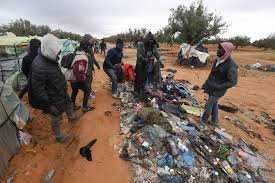Decision time for the EU’s strategy on migration

Brussels: The EU’s aggressive plans to stem the tide of irregular migration from North Africa have hit unexpected turbulence. Despite allocating billions of euros and crafting intricate agreements that would make any policy wonk blush, the EU finds itself grappling with a sobering reality: Key partners Egypt and Tunisia show little interest in deepening cooperation on border controls and migrant returns.
Other countries could follow suit and this unanticipated resistance, revealed in leaked EU documents, threatens to unravel the carefully constructed EU Pact on Migration and Asylum.
While Brussels touts a near-halving of Mediterranean crossings, the refusal of Cairo and Tunis to fully engage with the plans exposes the fragility of the EU’s prevailing strategy.
It might just be a negotiating strategy, as North African countries flex new-found muscles and leverage their growing influence as the new gatekeepers to “Fortress Europe.” Or it might be something more pragmatic, in terms of prioritizing Egyptian and Tunisian sovereign interests by extracting maximum benefits from this fortuitous “alliance.”
However, with the number of asylum claims in Europe potentially reaching 1 million this year, and less than a fifth percent of failed asylum seekers effectively deported, the EU’s approach faces its toughest test yet. As migration patterns shift and new routes emerge, the coming months will determine whether the bloc can salvage its external border strategy or if it must confront a fundamental rethinking of its migration policies.
Without cooperation from critical transit countries, the EU faces a cascade of potential upheavals
The EU’s migration pact is guiding policy through a robust framework with which migrant flows can be managed by utilizing extensive cooperation with neighboring regions, and bilateral deals with key transition countries such as Egypt, Libya, Tunisia, Mauritania and Morocco.
The basic idea is to continually strike deals that allow migrants to be intercepted en route to Europe and redirected to, or detained in, third-party countries, effectively turning these countries into migration buffer zones.
On paper, this helps to mitigate inflows of migrants and provides the EU with a mechanism to manage its borders more effectively. However, Egypt and Tunisia’s resistance exposes the precarious nature of a strategy that relies heavily on external agreements to resolve internal challenges or preempt inevitable crises, such as increased sociopolitical and economic pressures on the EU’s internal systems and safety-net programs.
Such a strategy faces significant hurdles when partner countries refuse to play along. This not only complicates immediate operational plans but also undermines the very foundational premise of the migration pact, which is that Europe’s migration crisis can be resolved through external delegation.
Without cooperation from critical transit countries, the EU faces a cascade of potential upheavals. Tunisia’s transformation into a transit hub for illegal migration exemplifies a shift that aligns poorly with EU objectives. If regional players refuse to act as gatekeepers, it forces Europe to reassess its external dependencies.
Should more countries follow the lead of Tunisia and Egypt, irregular migration could become less manageable, leading to heightened tensions within the EU as some member states are overwhelmed by new arrivals.
This domino effect could strain political unity and erode public trust in the EU’s ability to handle migration issues, fueling a rise in enduring nationalist sentiments and fracturing policy consensus across the union.
The internal disarray becomes even more pronounced when considering the knock-on effects of such refusals. Front-line countries such as Italy and Greece will be forced to take unilateral action that challenges the EU’s common policy framework.
Moreover, these dynamics can spill over into broader geopolitical tensions; regions outside Europe might view the EU’s overtures for cooperation as unreliable, heavy-handed or coercive, which could further stymie effective collaboration given the considerable logistical and security challenges associated with what Europe is asking of its “partners.”
For the governments in Cairo and Tunis, the calculus is rather simple: weigh the immediate burdens against the purported benefits. For example, although both countries receive about 8 billion euros ($8.7 billion) in financial assistance to bolster border controls, these funds barely scratch the surface of the intensive infrastructural and operational demands necessary to manage and stem the increasing flow of desperate migrants.
Beyond issues of feasibility, this surprising stance also teases some shrewd maneuvering; these countries understand that as Europe’s struggles with irregular migration escalate, they hold increasingly significant bargaining chips. The appearance of disinterest or indifference could therefore help to extract more-favorable terms, such as increased aid for troubled economies or the turning of blind eyes to human rights abuses, as countries count on Brussels’ pliancy.
The surprising move also indicates a shared concern that the much-touted migration pact is built on fragile foundations. Depending on what way the political winds blow, Brussels might very well decide to abandon it altogether, leaving “partner” nations in North Africa overextended and without support.
This is yet another indictment of the EU’s insistence on externalizing its border issues without installing adequate oversight mechanisms, even amid credible allegations that funding from Brussels is fueling rampant rights abuses and corruption.
It is premature to predict whether the disinterest displayed by Tunis and Cairo might force the EU to reevaluate its reliance on external partnerships. After all, without Egypt and Tunisia on board, the bloc faces a geographic and strategic gap in its “buffer zone” strategy that leaves southern Europe exposed and risks political upheaval. The knock-on effects could see Europe and North Africa back at square one, with images of overcrowded boats, overwhelmed coastguards and surging migrant death tolls dominating the narrative.
Worse, any vacuum left by the withdrawal of Egyptian and Tunisian cooperation is ripe for exploitation. Whether the culprits are the human traffickers who thrive on instability, or corrupt officials who might see this as an avenue for illicit gain, the situation could easily deteriorate.
This is yet another indictment of the EU’s insistence on externalizing its border issues without installing adequate oversight mechanisms, even amid credible allegations that funding from Brussels is fueling rampant rights abuses and corruption.
Europe therefore faces a critical decision in the coming months: adapt or persist. Continuing with the present strategy without the involvement of third-party countries would be tantamount to ignoring the glaring cracks in its preferred migration management strategies.
Yet, reversing course is not as simple as tearing up the pact and starting anew. The EU must consider a multipronged approach that emphasizes robust oversight and genuine collaboration over coercion. Investment in joint projects that offer significant economic incentives and ensure mutual benefits could create a more stable framework for partnerships.
In tandem, there is also a pressing need for deep introspection within the corridors of the EU. Policymakers must grapple with the moral dimensions of any planned strategies, recognizing that the real solutions lie in addressing the root causes of migration — conflicts, economic disparities and climate change — rather than simply shifting the burdens onto third-party countries.
Will the EU adapt to the shifting dynamics and rethink its approach to emphasize sustainable and ethical solutions, or will it double down on a fraught path that risks perpetuation of the very problems it seeks to solve? The answer to this question will not only shape the future of the bloc’s migration policy but also its standing and moral authority in a volatile world.





